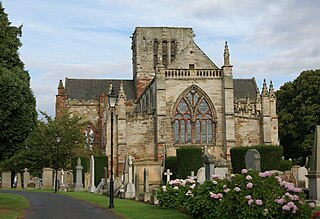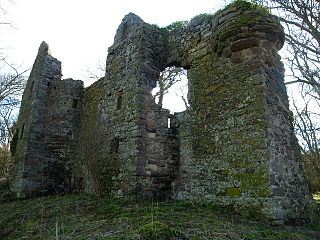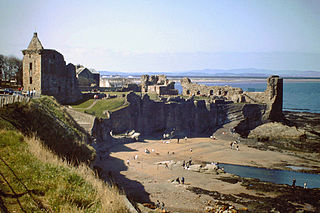Related Research Articles

Mary of Guise, also called Mary of Lorraine, was Queen of Scotland from 1538 until 1542, as the second wife of King James V. She was a French noblewoman of the House of Guise, a cadet branch of the House of Lorraine and one of the most powerful families in France. As the mother of Mary, Queen of Scots, she was a key figure in the political and religious upheaval that marked mid-16th-century Scotland, ruling the kingdom as queen regent on behalf of her daughter from 1554 until her death in 1560.
Broughty Castle is a historic castle on the banks of the River Tay in Broughty Ferry, Dundee, Scotland. It was completed around 1495, although the site was earlier fortified in 1454, when George Douglas, 4th Earl of Angus, received permission to build on the site. His son, Archibald Douglas, 5th Earl of Angus, was coerced into ceding the castle to the crown. The main tower house forming the centre of the castle with four floors was built by Andrew, 2nd Lord Gray, who was granted the castle in 1490.

James Hamilton, 3rd Earl of Arran (1537–1609) was a Scottish nobleman and soldier who opposed the French-dominated regency during the Scottish Reformation. He was the eldest son of James Hamilton, Duke of Châtellerault, sometime regent of Scotland. He was of royal descent, and at times was third or fourth in succession to the Scottish crown; several royal marriages were proposed for him, but he eventually never married. He went to France with Mary, Queen of Scots, where he commanded the Scots Guards. After returning to Scotland, he became a leader of the Protestant party against Mary and her French supporters. However, he went insane in 1562 and was confined for the rest of his life.

Henry Stewart, 1st Lord Methven was Master of the Scottish Artillery and third, and last husband, of Margaret Tudor, eldest daughter of Henry VII of England and Elizabeth of York.

The sieges of Haddington were a series of sieges staged at the Royal Burgh of Haddington, East Lothian, Scotland, as part of the War of the Rough Wooing, one of the last Anglo-Scottish Wars. Following Regent Arran's defeat at the battle of Pinkie Cleugh on Saturday 10 September 1547, he captured the town of Haddington. The intention was to form a network of mutually supporting English forts in lowland Scotland. The English forces built artillery fortifications and were able to withstand an assault by the besieging French and Scots troops supported by heavy cannon in July 1548. Although the siege was scaled down after this unsuccessful attempt, the English garrison abandoned the town on 19 September 1549, after attrition by Scottish raids at night, sickness, and changing political circumstance.

The Rough Wooing, also known as the Eight Years' War, was part of the Anglo-Scottish Wars of the 16th century. Following its break with the Catholic Church, England attacked Scotland, partly to break the Auld Alliance and prevent Scotland being used as a springboard for future invasion by France, partly to weaken Scotland, and partly to force the Scottish Parliament to confirm the existing marriage alliance between Mary, Queen of Scots, and the English heir apparent Edward, son of King Henry VIII, under the terms of the Treaty of Greenwich of July 1543. An invasion of France was also contemplated. Henry declared war in an attempt to force the Scottish Parliament to agree to the planned marriage between Edward, who was six years old at the start of the war, and the infant queen, thereby creating a new alliance between Scotland and England. Upon Edward's accession to the throne in 1547 at the age of nine, the war continued for a time under the direction of the Duke of Somerset, before Somerset's removal from power in 1549 and replacement by the Duke of Northumberland, who wished for a less costly foreign policy than his predecessor. It was the last major conflict between Scotland and England before the Union of the Crowns in 1603.

The Secret Bond was a document drawn up by Cardinal Beaton and signed at Linlithgow by a number of Scottish peers and lairds on 24 July 1543. They agreed to prevent the marriage of Mary, Queen of Scots, to Prince Edward of England. The document is sometimes called the "Linlithgow Bond".
Robert Stewart, 1st Earl of Lennox then 1st Earl of March was a Scottish nobleman of the family of Stewart of Darnley.

Sir Adam Otterburn of Auldhame and Redhall was a Scottish lawyer and diplomat. He was king's advocate to James V of Scotland and secretary to Mary of Guise and Regent Arran.

Ubaldini Migliorino, known also as "Captain Mellerin," was an Italian military engineer working in Scotland. He designed new fortifications at the entrances of Edinburgh Castle, Dunbar Castle, and possibly the walled town of Leith.

The Battle of Glasgow was fought on 16 March 1544, between Matthew Stewart, 4th Earl of Lennox and the Scottish Regent James Hamilton, 2nd Earl of Arran, and their adherents, during the minority of Mary, Queen of Scots. There was a second battle at Glasgow Muir in May 1544, known as the Battle of the Butts, between Arran and the Earl of Glencairn.
Mariotta or Maryon or Marion Haliburton, Lady Home was a 16th-century Scottish noblewoman. She varied the spelling of her forename between Mariotta, Marion, and Mary. She is remembered for her defence and negotiation of the surrender of Hume Castle after the Battle of Pinkie when the castle was surrounded by an English army. Afterwards she continued to struggle for the rights of her people at the village of Hume in the Scottish Borders, writing both to the English commander and the Scottish leader.

George Douglas of Pittendreich was a member of the powerful Red Douglas family who struggled for control of the young James V of Scotland in 1528. His second son became James Douglas, 4th Earl of Morton and Regent of Scotland. Initially, George Douglas promoted the marriage of Mary, Queen of Scots and Prince Edward of England. After war was declared between England and Scotland he worked for peace and to increase the power of Mary of Guise, the widow of James V.

Sir Peter Young (1544–1628) was a Scottish diplomat, Master Almoner, and tutor to James VI of Scotland.

The siege of St Andrews Castle (1546–1547) followed the killing of Cardinal David Beaton by a group of Protestants at St Andrews Castle. They remained in the castle and were besieged by the Governor of Scotland, Regent Arran. However, over 18 months the Scottish besieging forces made little impact, and the Castle finally surrendered to a French naval force after artillery bombardment. The Protestant garrison, including the preacher John Knox, were taken to France and used as galley slaves.
Alexander Crichton of Brunstane,, was a Scottish Protestant laird who advocated the murder of Cardinal David Beaton and supported the plan for the marriage of Mary, Queen of Scots and Prince Edward of England. In contemporary letters and documents Alexander is known by variant spellings of "Brunstane," his territorial designation. The original House of Brunstane was near Penicuik, and another Crichton estate at Gilberstoun near Portobello, Edinburgh later became known as Brunstane.

John Stewart, Commendator of Coldingham (1531–1563) was a Scottish landowner.
Andrew Melville of Garvock was a Scottish courtier and servant of Mary, Queen of Scots.
James Stewart of Cardonald (1512-1584) was a Scottish landowner and soldier.

Assured Scots were Scottish people who pledged to support English plans for Mary, Queen of Scots to marry Edward VI of England during the war of the Rough Wooing between 1543 and 1550. They took "assurances" and some received English pension money. Their motivations varied, and included favouring amity with England and their support for Protestant faith while Scotland was a Catholic country.
References
- ↑ Elizabeth Ewan, 'Dunlop, Annie Isabella', Elizabeth L. Ewan, Sue Innes, Siân Reynolds, Rose Pipes, Biographical Dictionary of Scottish Women (Edinburgh, 2018), p. 127.
- ↑ Marcus Merriman, The Rough Wooings (Tuckwell: East Linton, 2000), pp. xix, 102.
- ↑ Dunlop, Annie I. (1947). "Scottish Student Life in the Fifteenth Century". The Scottish Historical Review. 26 (101): 47–63. ISSN 0036-9241.